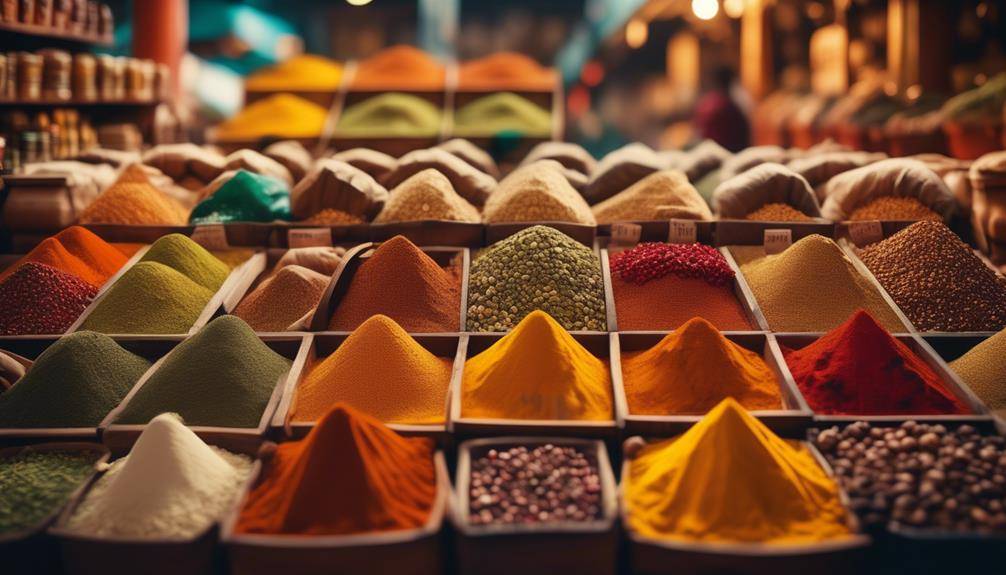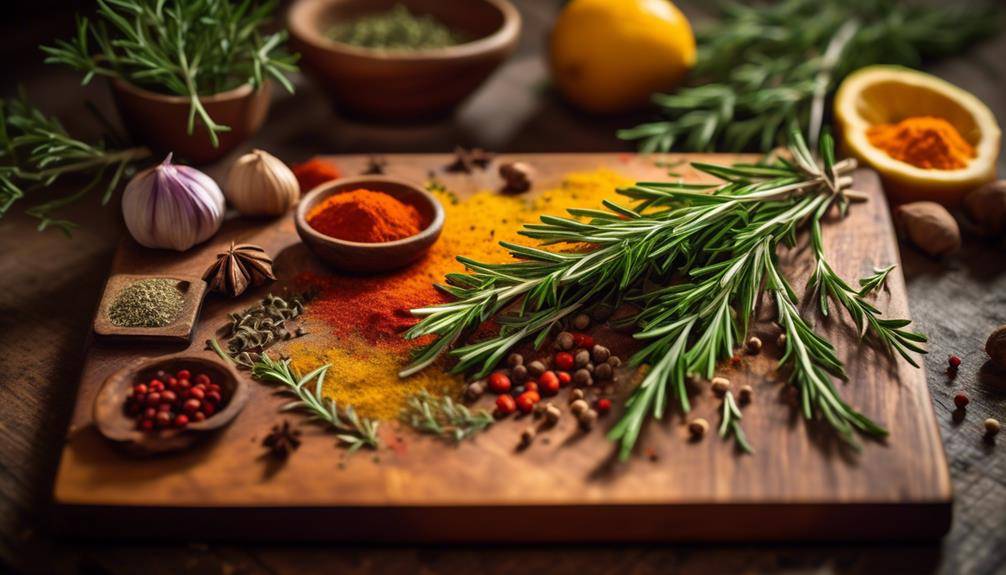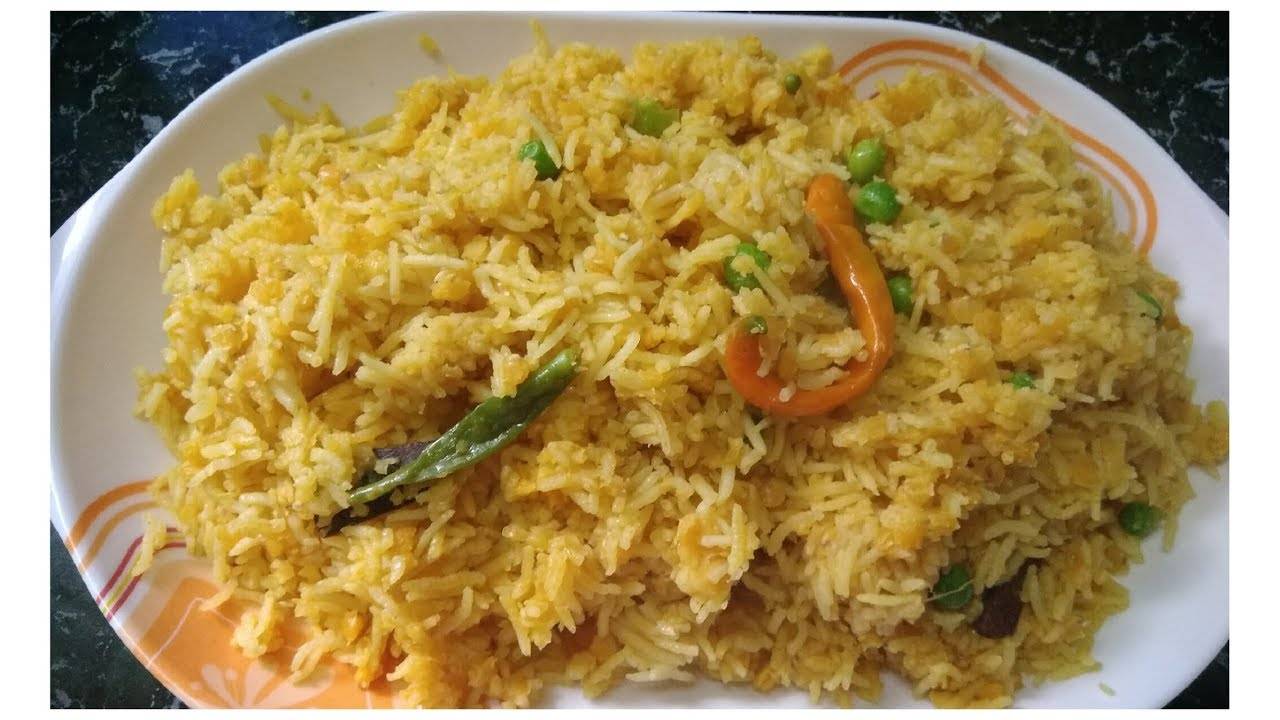10 Amazing Tips For Mastering Flavor Pairing With Spices

Mastering Flavor Pairing With Spices; Are you tired of bland and uninspiring meals? Are you ready to take your cooking to the next level and create dishes bursting with flavor? Look no further, because we have the ultimate guide to mastering flavor pairing with spices. These 10 tips will revolutionize the way you season your food, elevating your culinary creations to new heights. From understanding spice profiles to discovering regional flavor combinations, you’ll be equipped with the knowledge and skills to create mouthwatering dishes that will leave your taste buds begging for more. So, get ready to transform your cooking and unlock a world of delicious possibilities.
Start With the Basics
To master flavor pairing with spices, it is essential to begin with a solid understanding of the basics. In this subtopic, we will discuss the importance of starting with the basics when it comes to spice pairing techniques and flavor experimentation.
When it comes to spice pairing, experimentation is key. It is important to try different combinations of spices to discover unique and delicious flavor profiles. By starting with the basics, you can build a foundation of knowledge that will allow you to create complex and well-balanced dishes.
One of the first things you need to know is basic spice knowledge. Understanding the flavor profiles and characteristics of different spices will help you create harmonious combinations. For example, spices like cumin and coriander have earthy and warm flavors, while spices like cinnamon and nutmeg have sweet and aromatic notes. By understanding these basic characteristics, you can begin to build flavor profiles that complement each other.
Building flavor profiles is another key aspect of spice pairing. By combining spices with similar flavor profiles, you can create a more cohesive and balanced dish. For example, if you are cooking a dish with a Mediterranean influence, you might pair spices like oregano, thyme, and rosemary for a robust and herby flavor profile. On the other hand, if you are aiming for a spicy and bold taste, you might combine spices like cayenne pepper, paprika, and chili powder.
Understand Spice Profiles
To understand spice profiles, it is important to familiarize yourself with spice characteristics, such as heat level, aroma, and flavor intensity. This knowledge will help you determine the flavor compatibility between different spices and ingredients. By mastering spice pairing techniques, such as contrasting or complementing flavors, you can create harmonious and well-balanced dishes that elevate the overall taste experience.
Spice Characteristics
Understanding the characteristics of spices is essential for mastering flavor pairing and creating culinary masterpieces. When it comes to spice pairing techniques, it is important to consider the taste profiles of different spices. Each spice possesses unique characteristics that can greatly impact the overall flavor of a dish. For example, spices like cinnamon and nutmeg have a warm and sweet profile, making them ideal for desserts and baked goods.
On the other hand, spices like cumin and paprika have a smoky and earthy profile, which pairs well with savory dishes like stews and roasted meats. By balancing taste profiles, you can create harmonious flavor combinations that enhance the overall taste experience. So, take the time to understand the characteristics of spices and experiment with different combinations to elevate your culinary creations.
Flavor Compatibility
Now that you have a solid understanding of the characteristics of spices, it’s time to delve into the concept of flavor compatibility by exploring the profiles of different spices. Flavor pairing techniques involve combining spices that complement each other, enhancing the taste profiles of your dishes.
When balancing taste profiles, it is important to consider the intensity, heat, and flavor notes of each spice. For example, spices with similar flavor notes, such as cinnamon and nutmeg, can be paired together to create a warm and aromatic flavor profile. On the other hand, spices with contrasting flavors, like cayenne pepper and lime, can create a bold and tangy taste. By understanding the profiles of different spices, you can confidently experiment with flavor combinations and create unique and delicious dishes.
Spice Pairing Techniques
Begin by studying the profiles of different spices to understand spice pairing techniques. Spice pairing techniques involve the art of combining spices to create harmonious and flavorful combinations. By understanding the individual characteristics of each spice, you can enhance the flavors of your dishes and create a more balanced and enjoyable culinary experience.
When pairing spices, it is important to consider their flavor profiles, such as their level of heat, sweetness, bitterness, or earthiness. Some spices have complementary flavors, while others create contrasting flavor profiles. Experimenting with different spice combinations can lead to exciting flavor discoveries. Additionally, consider using flavor enhancement methods such as toasting or grinding spices to release their essential oils and intensify their flavors. By mastering spice pairing techniques, you can elevate your dishes to new levels of deliciousness.
Experiment With Complementary Flavors
To master flavor pairing with spices, you must understand the importance of harmonizing flavors and balancing taste profiles. By experimenting with complementary flavors, you can create dishes that are well-rounded and satisfying to the palate. Achieving this balance requires a careful selection of spices that enhance and complement each other, resulting in a harmonious and delightful culinary experience.
Harmonizing Flavors
Experiment with complementary flavors to harmonize the taste profiles of your dishes and elevate their overall flavor. When it comes to flavor pairing techniques, understanding taste bud preferences is crucial. By combining flavors that complement each other, you can create a well-balanced and satisfying dish. Consider pairing sweet and savory flavors, such as adding a touch of honey to a spicy curry.
The sweetness will help balance the heat and create a harmonious taste experience. Another option is to experiment with contrasting flavors, like combining tangy citrus with rich and creamy ingredients. This contrast adds depth and complexity to the dish. Additionally, don’t be afraid to explore the world of herbs and spices. They can enhance and unite the flavors in your dishes, resulting in a truly delightful culinary experience.
Balancing Taste Profiles
To achieve a well-balanced and satisfying dish, it’s essential to explore complementary flavors that harmonize the taste profiles of your dishes and elevate their overall flavor. Balancing flavor combinations is a crucial aspect of creating depth in dishes. When experimenting with spices, it’s important to consider how different flavors interact with each other.
Some spices have the ability to enhance and intensify the taste of others, while others can mellow out strong flavors. For example, the sweetness of cinnamon can balance the heat of chili powder, creating a well-rounded and flavorful dish. Similarly, the earthiness of cumin can complement the brightness of coriander, adding complexity to your dishes. By understanding the interplay of flavors and experimenting with complementary combinations, you can create dishes that are rich in taste and depth.
Balance Heat and Sweetness
Achieving the perfect balance between heat and sweetness is crucial when mastering flavor pairing with spices. When it comes to adding spices to your dishes, finding the right balance between these two elements can elevate your culinary creations to a whole new level. Here are four key tips to help you achieve the ideal harmony between heat and sweetness:
- Understand the heat levels of spices: Different spices have varying levels of heat, ranging from mild to fiery. Familiarize yourself with the Scoville scale, which measures the heat of peppers and other spicy ingredients. This will allow you to choose spices that complement the level of heat you desire in your dish.
- Balance heat and acidity: Alongside sweetness, acidity plays a significant role in flavor balance. The tartness of acidic ingredients, such as lemon juice or vinegar, can help counterbalance the heat of spices. Experiment with adding a touch of acidity to your dishes to create a harmonious blend of flavors.
- Consider texture: Texture can greatly influence the perception of heat and sweetness in a dish. Crispy or crunchy elements can help balance out the spiciness, while creamy or velvety textures can enhance the perception of sweetness. Incorporating different textures can add depth and complexity to your dishes.
- Start with small amounts: When adding spices to your dish, it’s best to start with a small amount and gradually increase to achieve the desired balance. This allows you to control the level of heat and sweetness without overpowering the other flavors.
Pair Spices With Protein
When it comes to pairing spices with protein, there are several options to consider. For meat, certain spice combinations work exceptionally well, enhancing the flavor and adding depth. Spice rubs can also be used to elevate the taste of seafood, creating a delicious and aromatic crust. Additionally, spices can be used to enhance the flavors of vegetarian protein options, adding complexity to plant-based dishes.
Meat and Spice Combinations
Enhance the flavor of your meat dishes by skillfully pairing spices with different types of protein. When it comes to meat and spice pairings, there are numerous combinations that can elevate your grilling experience. Here are four spice options to consider:
- Smoky Paprika: Add a rich and smoky flavor to your grilled meats with paprika. It pairs well with beef, pork, and even chicken, giving your dishes a robust and slightly sweet taste.
- Bold and Spicy Chipotle: For those who enjoy a kick of heat, try using chipotle powder. This spice adds a smoky and fiery flavor to grilled meats like steak, lamb, and chicken wings, creating a tantalizing taste experience.
- Aromatic Cumin: Cumin is a versatile spice that complements various meats, including beef, lamb, and chicken. It adds a warm and earthy taste, enhancing the natural flavors of the meat.
- Tangy and Zesty Lemon Pepper: Bring a burst of freshness to your grilled meats with lemon pepper seasoning. Ideal for chicken and fish, this combination of zesty lemon and bold pepper creates a tangy and flavorful profile.
Spice Rubs for Seafood
To further elevate your culinary skills, let’s now explore the world of spice rubs for seafood, enhancing the flavors of various types of protein with carefully chosen spices. Spice blends specifically designed for seafood can add depth and complexity to your dishes, taking your grilling techniques to the next level. When it comes to spice rubs for seafood, consider using blends that incorporate flavors like lemon zest, garlic, paprika, and cayenne pepper. These spices complement the natural flavors of seafood and provide a delightful contrast.
Whether you’re grilling fish, shrimp, or scallops, a well-balanced spice rub can enhance the taste and aroma of your dish. Experiment with different combinations and levels of spices to find the perfect balance of flavors for your seafood creations.
Vegetarian Protein and Spices
Spices can be paired with vegetarian protein options to elevate their flavors and create a delicious and well-balanced dish. Here are four ways you can enhance the taste of vegetarian protein alternatives using spices:
- Marinate tofu: Tofu is known for its neutral taste, but by marinating it with spices like cumin, paprika, and garlic powder, you can infuse it with bold and savory flavors.
- Spice up tempeh: Tempeh has a nutty flavor that can be enhanced by adding spices such as ginger, turmeric, and coriander. These spices will complement the earthy taste of tempeh and create a flavorful dish.
- Add depth with spice blends: Use spice blends like garam masala or curry powder to add depth and complexity to vegetarian proteins. These blends contain a combination of spices that work together to create a well-rounded flavor profile.
- Experiment with herbs and spices: Don’t be afraid to try different combinations of herbs and spices to add unique flavors to your vegetarian protein dishes. From smoked paprika to rosemary and thyme, the possibilities are endless.
Enhance Vegetables With Spices
When looking to elevate the flavor of your vegetables, consider incorporating a variety of aromatic spices for a tantalizing culinary experience. Spices have the power to transform ordinary vegetables into extraordinary dishes, adding depth and complexity to your meals. By enhancing the natural flavors of vegetables, spices can take your cooking to the next level.
To enhance the flavor of your vegetables, start by understanding the different flavor profiles of spices. For example, cumin and coriander can bring earthy and warm notes to roasted vegetables, while ginger and turmeric can add a zesty and vibrant taste to stir-fried veggies. Experiment with different combinations of spices to find your preferred flavor profiles.
When it comes to enhancing pasta dishes, spices can play a vital role in adding richness and depth to your sauces. For example, adding a pinch of red pepper flakes can give your tomato sauce a subtle heat, while oregano and basil can provide a fresh and aromatic flavor. Don’t be afraid to experiment with spices like smoked paprika or cinnamon to add a unique twist to your pasta dishes.
On the sweeter side, incorporating spices in desserts can elevate their taste to new heights. Cinnamon and nutmeg are classic choices for enhancing the flavor of desserts like apple pie or pumpkin bread. Cardamom and saffron can add an exotic touch to Indian-inspired desserts like rice pudding or gulab jamun. The key is to use spices in moderation to enhance the flavors without overpowering the sweetness.
Incorporating spices into your vegetable dishes is a simple yet effective way to elevate their flavor. By understanding the flavor profiles of spices and experimenting with different combinations, you can create tantalizing vegetable dishes that will impress even the most discerning palate. So, don’t be afraid to spice things up and take your vegetable dishes to new heights.
Use Spices for Marinades and Rubs
If you’re looking to add an extra layer of flavor to your dishes, consider utilizing spices for marinades and rubs. Marinades are a great way to infuse meat, poultry, or seafood with flavor before cooking, while rubs are a dry mixture that is applied directly to the surface of the food. Here are four techniques to enhance your marinades and rubs using spices:
- Experiment with different spice combinations: Mix and match spices to create unique flavor profiles. For a smoky and spicy marinade, try combining paprika, cumin, and chipotle chili powder. For a Mediterranean-inspired rub, use a blend of oregano, thyme, rosemary, and garlic powder.
- Use spice infused oils: Infusing oils with spices can take your marinades and rubs to another level. Heat your oil with spices like cinnamon sticks, star anise, or crushed red pepper flakes to release their flavors before using them in your marinade or rub. This adds a depth of flavor that plain oils cannot achieve.
- Let the flavors meld: When using a marinade, give it enough time to work its magic. Place your marinated meat, poultry, or seafood in the refrigerator for at least 30 minutes, or even overnight, to allow the flavors to penetrate the food. For rubs, it’s best to apply them at least 30 minutes before cooking to let the spices infuse into the meat.
- Adjust the salt level: Spices can enhance the taste of your marinades and rubs, but it’s essential to balance the flavors. Be mindful of the salt content in your spice blend and adjust it according to your taste preferences. Too much salt can overpower the other flavors, while too little can leave your dish tasting bland.
Explore Regional Flavor Combinations
To explore the diverse and captivating flavors of different regions, incorporate unique spice combinations into your marinades and rubs. Regional spice blends are a fantastic way to infuse your dishes with the distinct tastes and aromas of specific cuisines. Whether you’re interested in exploring the bold and fiery flavors of Latin America or the fragrant and aromatic spices of the Middle East, incorporating regional spice blends into your cooking will take your dishes to a whole new level.
One popular example of regional flavor combinations is fusion cuisine, which combines ingredients and cooking techniques from different cultures to create exciting and unique dishes. By incorporating regional spice blends into your fusion cuisine, you can create a harmonious blend of flavors that will tantalize your taste buds.
For example, if you’re interested in creating a fusion dish that combines Indian and Mexican flavors, you could use a spice blend that combines the warm and earthy flavors of cumin, coriander, and turmeric with the smoky and spicy flavors of chipotle and paprika. This unique blend of spices will add depth and complexity to your dishes, creating a truly memorable dining experience.
When exploring regional flavor combinations, it’s important to consider the balance of flavors. Experiment with different spice combinations and adjust the proportions to suit your taste. Don’t be afraid to get creative and try new things – that’s what makes cooking with spices so exciting!
Incorporating regional spice blends into your marinades and rubs is a fantastic way to explore the diverse and captivating flavors of different regions. Whether you’re cooking fusion cuisine or simply looking to add some excitement to your dishes, experimenting with unique spice combinations will elevate your cooking to new heights. So go ahead, embrace the flavors of the world and let your taste buds embark on a culinary adventure!
Don’t Forget About Texture
For a well-rounded culinary experience, it is essential to consider the texture of your dishes when exploring flavor pairing with spices. Texture plays a crucial role in creating a harmonious and enjoyable eating experience. By experimenting with different textures and adding spices to different cooking methods, you can elevate the flavors of your dishes to new heights. Here are four ways to enhance your culinary creations by paying attention to texture:
- Crispy and Crunchy: Adding spices to dishes that have a crispy or crunchy texture can create a delightful contrast. For example, you can sprinkle a blend of spices on top of roasted vegetables to enhance their natural crunchiness and add an extra layer of flavor.
- Creamy and Smooth: Creamy and smooth textures can be enhanced by incorporating spices that add depth and complexity. Consider adding spices like cumin or nutmeg to creamy soups or sauces to elevate their flavor and create a more satisfying mouthfeel.
- Tender and Juicy: For meats or vegetables that are tender and juicy, experiment with spices that can enhance their natural juiciness. You can marinate your protein with a mix of spices before grilling or roasting to infuse it with rich flavors and retain its succulence.
- Chewy and Satisfying: Chewy textures can be made even more satisfying by adding spices that provide a burst of flavor. Sprinkle some chili powder or paprika on top of chewy snacks like roasted chickpeas or nuts to create a delightful combination of chewiness and spiciness.
Trust Your Taste Buds
When it comes to flavor pairing with spices, trust your taste buds to guide you towards the perfect combination of flavors. Your instincts play a crucial role in identifying the flavors that complement each other and create a harmonious taste experience. Trusting your taste buds allows you to develop a palate that is finely tuned to the nuances of different spices and ingredients.
Trusting your instincts in flavor pairing means relying on your sensory perception and personal preferences. Each person’s taste buds are unique, and what might be appealing to one person may not be the same for another. Therefore, it is essential to trust your own judgment and experiment with different combinations to find what works best for you.
Developing your palate is a continuous process that involves exposing yourself to a wide variety of flavors and spices. By tasting and experimenting with different ingredients, you become more familiar with their individual characteristics and how they interact with other spices. This familiarity helps you make more informed decisions when it comes to pairing flavors.
To trust your taste buds and develop your palate, it is crucial to pay attention to the flavors and aromas of the spices you use. Take the time to savor each bite and notice the different elements that come together to create a dish. This mindfulness allows you to appreciate the subtle nuances of spices and develop a deeper understanding of how they can be combined to enhance the overall flavor profile.
Frequently Asked Questions: Mastering Flavor Pairing With Spices
How Do I Know Which Spices Go Well Together?
You’ll know which spices go well together by experimenting with different combinations. Avoid common mistakes like using too many overpowering spices or not balancing flavors. Try unique combinations to create your own signature dishes.
Can I Use Dried Spices Instead of Fresh Ones?
You can use dried spices instead of fresh ones. Pros include longer shelf life and convenience. Cons may include less intense flavor. To rehydrate dried spices, soak them in water or oil before using for optimal flavor.
Is It Necessary to Toast Spices Before Using Them?
Toasting spices before using them is necessary for enhanced flavor. It brings out their natural oils and intensifies their taste. To properly toast spices, heat them in a dry pan until fragrant.
Can I Substitute One Spice for Another in a Recipe?
Yes, you can substitute one spice for another in a recipe. Experiment with unconventional pairings to discover unique flavor combinations. Be mindful of the intensity and flavor profile of each spice for successful substitutions.
How Do I Store Spices to Maintain Their Freshness?
To maintain spice freshness, store them in airtight containers in a cool, dark place. Avoid keeping them near heat sources or moisture. Check for any signs of spoilage, such as loss of aroma or color, and replace accordingly.
Conclusion
In conclusion, mastering flavor pairing with spices requires a solid understanding of spice profiles, experimentation with complementary flavors, and balancing heat and sweetness. Pairing spices with protein, using them for marinades and rubs, and exploring regional flavor combinations are also key. Additionally, considering texture and trusting your taste buds are important factors in achieving successful flavor pairings. By following these 10 tips, you can elevate your culinary skills and create flavorful dishes that will impress your taste buds.








